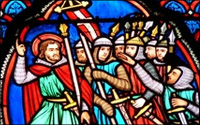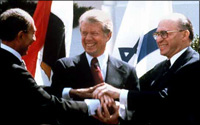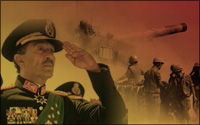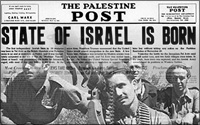
In the early part of the fifth century the city of Rome fell, and with it came the end of the Roman Empire.
Western Europe now descended into the period called the Dark Ages, which lasted almost 600 years. We have no record of what happened during that time. All the advances of Roman civilization – including its law, architecture, engineering, mathematics and roads – all disappeared as though it was never here.
The only thing that survived was the Roman legacy of Christianity.
However, it was a Christianity mixed with a great deal of paganism. It also had an intensively strong anti-Semitic bent to it. The language used by Church Fathers of the fifth and sixth centuries found its way into the writings of Julius Streicher, the Nazis, as well as the Russian and Arab propagandists.
This caricature of the Jew has, unfortunately, remained imprinted on European society till our very day. It has not gone away. We are almost powerless to do anything about it.
Theological Conundrums
In the writings of the early Church Fathers one can see how the Church was bothered by a number of theological problems regarding the Jews. One was that Jesus was a Jew. If so, how could you say that all Jews were evil? In fact, you had to say that the Jews were superior.
After a period of time, the Church Fathers came up with the following solution: The Jews were God’s chosen people. That is why the Torah was revealed to them at Sinai. That is why they had prophets, whereas the rest of the world did not. The Jews were blessed with monotheism and the one true religion. And God so loved the Jewish people that He did not send the Messiah as an Italian, Irishman, Roman or anything else. He sent him as a Jew.
Nevertheless, the theological argument ran, at their supreme moment of choice, the Jewish people rejected Jesus. By rejecting him they rejected God as well. They abandoned their chosen role. Therefore, they went from the highest of people to the lowest of people.
Another theological problem the Church Fathers had to deal with was the commandments in the Torah. If the Torah was true and if it was God’s revelation, how come Christians do not wear tefillin (e.g. Exodus 13:9, 16) and fringes (i.e. tzitzis; Numbers 15:38, Deuteronomy 22:12) or keep the Sabbath (the Ten Commandments) and the dietary laws (i.e. eating kosher food) – and all the other commandments one finds? If it was true once, why wasn’t it true always?
Consequently, the Church developed a doctrine that the “New” Testament abrogated the “Old.” In other words, the “Old” Testament was valid until the year zero. In that year, God changed His mind and substituted belief in Jesus for the observance of the commandments.
The Church’s Greatest Dilemma
Arguably the greatest dilemma, though, was the very survival of the Jewish people.
Already by the year 400, it began to be perplexing to the Christian world why the Jews survived. After all, it had already been 330 years since the Temple in Jerusalem had been destroyed and the Jewish people driven from their homeland. The Romans swallowed up hundreds and hundreds of small nations, tribes, societies and cultures. They are not even remembered any longer.
Yet, here the persecuted, scattered Jewish people somehow were surviving – and showed no signs of giving up. The problem for Christianity was: Why?
The problem was compounded if you said – as the Church did – that the Jewish people were intrinsically evil and had done the greatest wrong in the history of civilization by rejecting Jesus. This was compounded even more when the Church came upon the doctrine of deicide.
Only in our time, through Vatican II, has the Church officially withdrawn that concept. Of course, when a concept has been floating around for 1,500 years it does not die easily. The canard that Jews are Christ-killers still reverberates in the world today.
In any event, the problem for the Church theologians was that if the Jews were guilty of all that, what were they still doing here?
The Witness People
In response, the Church developed the notion of the Witness People.
The early Christians believed firmly that Jesus was coming back very soon. One can see in the writings of the early Christian fathers that they were very “other-worldly.” They said, in effect, that there was no use doing anything in the world. In fact, this is part of the idea that contributed to the Dark Ages. They said there was no use building up anything because the Kingdom of God was imminent. What then is the use of building great cities if tomorrow the Kingdom of God will be here? God does not need another skyscraper. The idea that the Second Coming was imminent served as a brake on any sort of progress in civilization.
Consequently, since the Second Coming was imminent there had to be someone to get up and say in effect, “We were wrong. This is the Messiah and we now accept him.”
Who was the logical candidate for that task, they reasoned? The people of Israel.
Hence, the idea of the Witness People.
From the notion of the Witness People there arose during the Middle Ages (about the 12th century) the idea of the “Pope’s Jews.” The head of the Roman Catholic Church kept a number of Jews in Rome under his personal protection. All the other Jews in the world were expendable. However, he had to keep a certain amount to be sure that there would be Jews around to witness the Second Coming.
The “Pope’s Jews” existed literally until the Second World War. Indeed, the only time Pope Pius XII protested to the Gestapo and Nazis about the deportation and extermination of Jews was when they came to take Rome’s 7,000 Jews, which including “his” Jews.
Since the introduction of the Witness People doctrine, many centuries have passed and the Church has undergone a great deal of change… as has Western civilization. The faith of Western man in many things has been shaken, including this doctrine. The idea of the Witness People has become harder and harder to “sell.” The longer it takes, the less sense it makes.
The Two Churches
As Christianity spread in its early centuries, the Church split into two.
The Western Church today is called the Roman Catholic Church. “Catholic” is a Greek word meaning “universal” (thus rendering: “The Universal Roman Church”). The Eastern Church today is called the Greek Orthodox Church. Likewise, the Russian Orthodox Church, the Armenian Church and others affiliated with the eastern rites are classified as the Eastern Church.
The Eastern Church was centered in Byzantium, which would be renamed Constantinople (and today is called Istanbul). Byzantium refused to accept the primacy of Rome and never really had a pope. The Eastern Church is more primitive and paganistic. It worships icons, paintings, relics, bones of the saints and the like. Though such things can be found in the Western Church, in the Eastern Church it is found to a much greater degree.
Much of the struggle of the Jewish people in the early days of Christianity was against the Eastern Church, not the Western. The main reason was because when Rome fell, the Western Church went into decline. During the 150-year period between the fall of Rome and the coming of the Muslims, the Byzantine Empire was strong. And most of the Jews lived under the Byzantine Empire – either in the land of Israel or Babylon. Therefore, the Jewish struggle with Christianity at that time was the struggle against the Eastern Church.
The Turmoil of the Tail End of the Talmudic Era
During this period, the Jews in Babylon lived in a type of secure pocket, a bubble if you will. The Christians did not make inroads there even though it was under the Byzantine Empire. That is what allowed the Jews to develop and have the autonomous life they had.
During this period, the Talmud was completed in Babylon. The Jerusalem Talmud had been completed almost 200 years earlier. Now the Babylonian Talmud was finished and put into the state we have it today, more or less.
Part of the reason that the Talmud came to an end was because Jewish autonomy came to an end. The Persians marched east, conquered Babylon and continued to the land of Israel. Some Jews made an alliance with the Persians to throw out the Byzantine Christians and take back the land of Israel. Rumors about rebuilding the Temple and reestablishing the Jewish presence in Jerusalem echoed throughout the Jewish community.
The emperor of the Byzantine Empire during this time (the early 500s) was Justinian, a very devout Christian who felt that this struggle against the Persians was a holy war. From now on in general, the wars became holy wars. Regular wars are bad enough. But fighting over money, land or Helen of Troy, for that matter, has certain limits. You take the booty, occupy the land or bring back Helen. But holy wars have no limit. Everything the army does is justified. It is all for the sake of God.
We will see that when Mohammed comes along he will inherit that idea of a holy war and develop it to its “highest” form.
Justinian engaged in a holy war against the Persians. Many Jews – especially those in Israel with dreams of driving out the Byzantines and rebuilding the Temple — allied themselves with the Persians. Unfortunately, the Persians lost.
Justinian took out his wrath on the Jews. The Jewish presence in the land of Israel almost came to an end. According to some records, less than a thousand Jews remained. The Christians burned all the synagogues. One can see to this day in northern Galilee the ruins of hundreds of such scorched synagogues. Most of those were destroyed during Byzantine times.
Jewish communities in the land Israel were uprooted and Jews were forced to leave Israel in droves. They would settle as far as North Africa, as well as in what is today Yugoslavia, Turkey, Afghanistan and southern Russia, the Caucuses.
The Babylonian Talmud marks the end of that period. It is a though God allowed the Jewish people to get it all down in writing before it was too late, because they would never again have such an opportunity. They would never again live in such an isolated island of protection against the sea of Christianity and Islam.
Repercussions Today
Despite the efforts of the Byzantine Christians, Christianity did not take a strong hold in the Middle East. The Persians, Parthians and Afghans remained pagan. The Bedouin tribes remained pagan. The city-dwellers, though nominally Christian, will give it up and become Muslim very easily, as we will see.
Part of the struggle that exists today in places throughout the Middle East is rooted in the struggle of Christianity to try to recoup its losses. It is very strange, from a Christian theological perspective, that the Holy Land and the Holy City does not belong to the Christian religion. Part of the Church’s relationship to the State of Israel today is a theological problem. It is hard for them to say that Jerusalem should be the capital of the Jews; that it is not Christian.
The struggle of Christianity is forever intensified by these contradictions to its theology. And with coming of the Muslims, who will be every bit as strong and stubborn, it is no wonder that we are talking about a conflict that spans 1,400 years.











